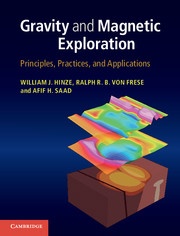Book contents
- Frontmatter
- Dedication
- Contents
- Preface
- Acknowledgements
- 1 Introduction
- Part I Gravity exploration
- Part II Magnetic exploration
- 8 The magnetic method
- 9 Magnetic potential theory
- 10 Magnetization of Earth materials
- 11 Magnetic data acquisition
- 12 Magnetic data processing
- 13 Magnetic anomaly interpretation
- Part III Applications
- Appendix A Data systems processing
- References
- Index
9 - Magnetic potential theory
from Part II - Magnetic exploration
Published online by Cambridge University Press: 05 May 2013
- Frontmatter
- Dedication
- Contents
- Preface
- Acknowledgements
- 1 Introduction
- Part I Gravity exploration
- Part II Magnetic exploration
- 8 The magnetic method
- 9 Magnetic potential theory
- 10 Magnetization of Earth materials
- 11 Magnetic data acquisition
- 12 Magnetic data processing
- 13 Magnetic anomaly interpretation
- Part III Applications
- Appendix A Data systems processing
- References
- Index
Summary
Overview
Like the gravity method described in Chapter 3, the magnetic method is a potential field method. Magnetic potential is defined by the amount of work done in moving a point dipole from one position to another in the presence of a magnetic force field acting upon the point dipole. The rate of change of the potential is the component of force in that direction which is related to the magnetic field strength measured in the magnetic method. As in the gravity method, Laplace's and Poisson's equations, Gauss' law, and Poisson's theorem are useful in understanding the properties of the magnetic field and in its analysis.
The magnetic effects of an arbitrary distribution of magnetization are evaluated by the summed effects of the point dipoles that fill out the volume. Magnetic effects of idealized bodies with simple symmetric shapes can be modeled with closed-form analytical expressions. For a general source with irregular shape, however, the magnetic effect must be numerically integrated by filling out the volume with idealized sources and summing the idealized source effects at the observation point. The numerical integration can be carried out with least-squares accuracy by distributing the idealized sources throughout the irregular body according to its Gauss-Legendre quadrature decomposition. Thus, the magnetic effects of all conceivable distributions of magnetization can be modeled to investigate the significance of magnetic anomalies.
- Type
- Chapter
- Information
- Gravity and Magnetic ExplorationPrinciples, Practices, and Applications, pp. 235 - 251Publisher: Cambridge University PressPrint publication year: 2013



